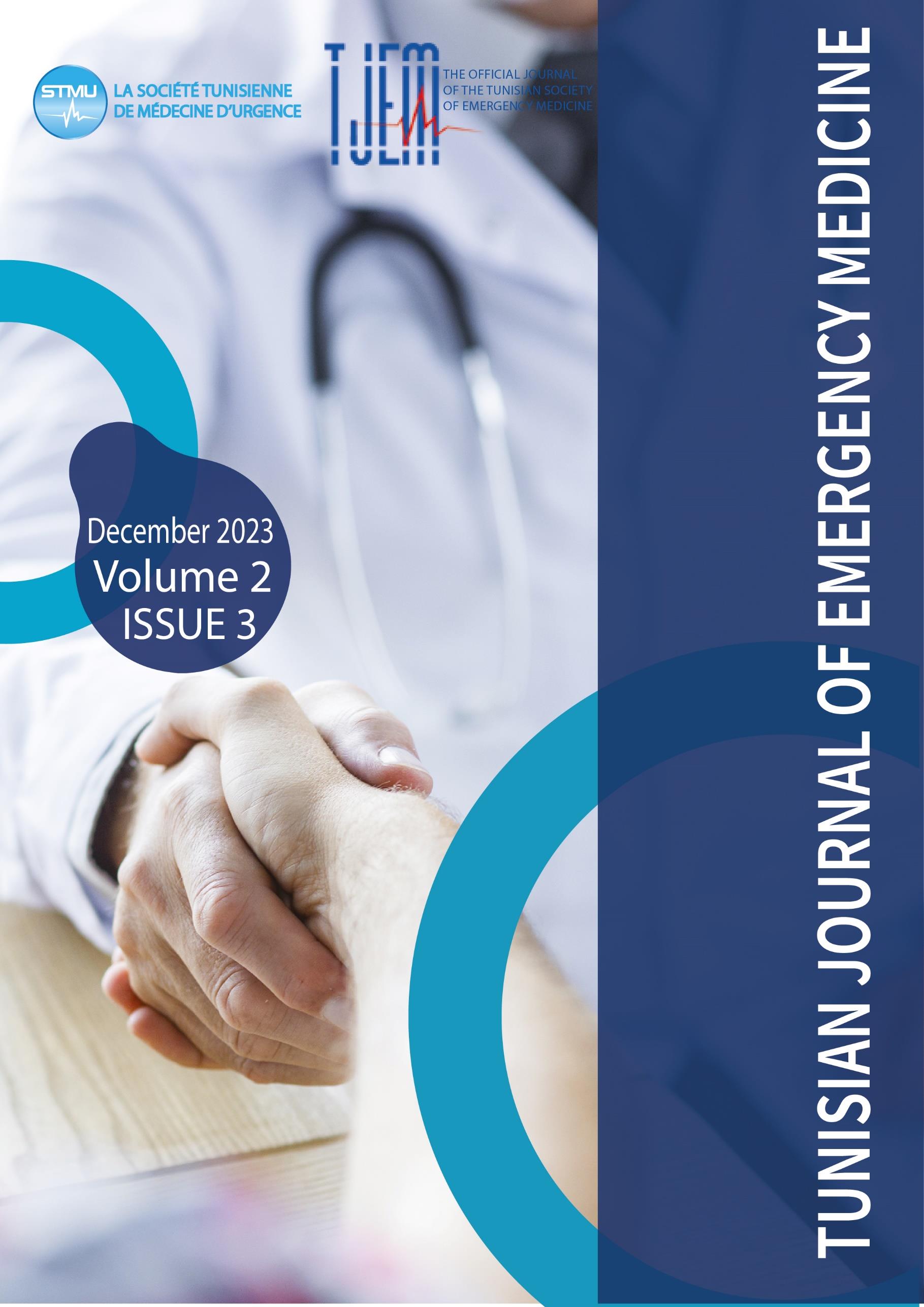The beneficial learning by simulation in the acquisition of non-technical skills among medical students
Dorra Loghmari, Sarra Soua, Mehdi Zorgati, Mohamed El Hedi Ahmed, Rabeb Mbarek, Sondes Laajimi, Haifa Bradai, Naoufel Chebili
DOI:
https://doi.org/10.0000/jbvjgf73Keywords:
Crisis Resource Management, High Fidelity simulation training, Medical studentsAbstract
Introduction: Medical simulation is a new learning method recently introduced in medical education and has grown tremendously. "Never the first time on the patient", it is with this objective that medical simulation has become for several years an essential teaching method for health professionals and medical students. It is proven to improve both technical and non-technical skills (NTSs).
Methods: We carried out a pre-experimental study at the simulation center of the emergency medical service of the eastern center of Tunisia and the simulation center of the Faculty of Medicine of Sousse during the academic year 2020-2021. Our target population was students in the third year of the second cycle of medical studies.
We led four days of simulation-based training; it was included the community health program of the Faculty of Medicine of Sousse. NTSs were evaluated by the Anesthesia Non-Technical Skills (ANTS) score, at the start of the training (t0) (Workshop 2), at the end of the training (t1) (Workshop 6-7), and during the practical exam (t2).
Results: Our study population consisted of 67 medical students from the Faculty of Medicine of Sousse. Most students were females (67.7%). The mean age was 23.16 (±0.7).
The mean ANTS score before training at (t0) was 30.85+/- 10.8. At the end of the training, the mean ANTS score (t1) became 44.36+/- 8.8 (p <0.001). At the final assessment, the mean ATNS score at (t2) was 48.99+/-11.8. The difference in mean between the assessment at t0 and t1 and the final assessment (t2) was statistically significant with p <0.001. We compared the means of different items of the ANTS score, during the training to the end, and we found a significant improvement in work organization (10,03,10,94 and 15,79), teamwork (9,96,13,96 and 14,6) situational awareness (4,61, 8,91 and 9,25) and Decision-making (5.34, 7.66 and 9.34) with p < 0.001.
Conclusion: Simulation-based training for the medical and paramedical public contributes to patient safety and more effective care provided in critical situations. Our study confirmed the importance of this teaching method in acquiring and strengthening NTS.
Downloads
Published
Issue
Section
License
Copyright (c) 2023 Tunisian Journal of Emergency Medicine

This work is licensed under a Creative Commons Attribution-NonCommercial-ShareAlike 4.0 International License.
How to Cite
Similar Articles
- Dorra Loghmari , Compassion satisfaction and fatigue among healthcare professionals in the emergency medical services during the COVID-19 pandemic , Tunisian Journal of Emergency Medicine: Vol. 2 No. 2 (2022): TJEM Vol2 Issue2
- olfa DJEBBI, Acute cerebral insults in the emergency department: epidemiology and predictive factors of highly sensitive troponin level’s increase , Tunisian Journal of Emergency Medicine: Vol. 2 No. 3 (2023): TJEM Vol2 Issue3
- Dorra Loghmari , Epidemiological and prognostic factors associated with road traffic accidents occurring in the Center East of Tunisia. , Tunisian Journal of Emergency Medicine: Vol. 2 No. 3 (2023): TJEM Vol2 Issue3
- Houda BEN SOLTANE, Predicting diabetic ketoacidosis severity score: proposal of a therapeutic strategy adapted to the emergency department , Tunisian Journal of Emergency Medicine: Vol. 2 No. 2 (2022): TJEM Vol2 Issue2
- olfa djebbi, A dramatic course of COVID-19-associatedmeningoencephalitis without respiratoryinvolvement: a case report , Tunisian Journal of Emergency Medicine: Vol. 2 No. 4 (2024): TJEM Vol2 Issue4
- Olfa chakroun-walha, Acute myocarditis complicating severe chloralose intoxication: A case report , Tunisian Journal of Emergency Medicine: Vol. 2 No. 3 (2023): TJEM Vol2 Issue3
- Rania Hammami, Syrine Triki, Aimen Dammak, Faiza Safi, Olfa Chakroun , An abrupt cardiogenic shock in a female at the era of COVID 19 pandemic lockdown , Tunisian Journal of Emergency Medicine: Vol. 3 No. 1 (2025): TJEM 2025: Vol.3 Issue 1
- Olfa chakroun-walha, Cade oil poisoning in pediatrics: about 12 cases , Tunisian Journal of Emergency Medicine: Vol. 2 No. 3 (2023): TJEM Vol2 Issue3
- Marwa TOUMIA, Fatma Zaouali, Lamia Bouzgarrou, Guillain–Barré syndrome after an asymptomatic COVID‐19 Infection: a case report , Tunisian Journal of Emergency Medicine: Vol. 3 No. 1 (2025): TJEM 2025: Vol.3 Issue 1
You may also start an advanced similarity search for this article.
Most read articles by the same author(s)
- Haifa BRADAÏ, Rabeb Mbarek, Sondes Laajimi, Dorra Loghmari, Mounir NAIJA, Atrial flutter mimicking ST-elevation myocardial infarction: A case report , Tunisian Journal of Emergency Medicine: Vol. 3 No. 1 (2025): TJEM 2025: Vol.3 Issue 1
- Sondes laajimi, haifa bradai, Nabil Chebbi, Dorra Loghmari , imen EL KISSI, Naoufel Chebili , rabeb Mbarek, Specific Features of Chest Pain in Young People treated in Prehospital Care , Tunisian Journal of Emergency Medicine: Vol. 3 No. 1 (2025): TJEM 2025: Vol.3 Issue 1
- Dorra Loghmari , Epidemiological and prognostic factors associated with road traffic accidents occurring in the Center East of Tunisia. , Tunisian Journal of Emergency Medicine: Vol. 2 No. 3 (2023): TJEM Vol2 Issue3
- Rabeb Mbarek, Khouloud Hamdi, Sarra Soua, Hela Abroug, Sondes laajimi, haifa Bradai, Dorra Loghmari , Asma SRIHA, Semir Nouira, Prehospital Particularities of Covid-19 infection and factors associated with its severity during the omicron variant wave (East-center of Tunisia) , Tunisian Journal of Emergency Medicine: Vol. 2 No. 4 (2024): TJEM Vol2 Issue4
- Dorra Loghmari , Compassion satisfaction and fatigue among healthcare professionals in the emergency medical services during the COVID-19 pandemic , Tunisian Journal of Emergency Medicine: Vol. 2 No. 2 (2022): TJEM Vol2 Issue2
- Dorra Loghmari , Anevrysmal subarachnoid hemorrhage with electrocardiographic abnormalities: a case report , Tunisian Journal of Emergency Medicine: Vol. 2 No. 3 (2023): TJEM Vol2 Issue3

